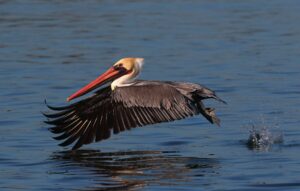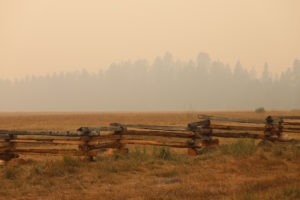The 2020 California fire season was the biggest in our state’s history and 2021 wasn’t far behind. With millions of acres of newly burned land in Northern California, much of it in familiar parks, open space areas and national forests, Bay Area residents will need to think about how they recreate a little more carefully, in some cases for a long time to come. While most people don’t dream of playing on charred moonscapes, the odds you’ll at least need to pass through a burned area while recreating grows greater every year.
I spoke with experts in fire ecology, Bay Area land managers and a PCT hiker named Caribbean Joe to get a list of dos and don’ts for hiking and camping once the smoke has cleared.
Know what’s open and respect closures; they are for your safety. Lots of areas will remain closed until major hazards can be mitigated, and the length of time an area is closed can vary widely. While grasslands bounce back from fire quickly, usually within a year, forests can still show fire effects, and remain dangerous, for many years. For example, when the CZU Lightning Complex Fire burned 97 percent of Big Basin State Park in August 2020 small fires were still igniting that had smoldered inside tree trunks almost a year later.
Beware damaged or dead trees, especially while camping and during high wind or rain. Pass through areas with standing dead trees quickly, don’t take breaks under damaged trees, and certainly don’t set up a tent in the fall zone of a damaged tree. In addition to falling branches, damaged roots can make trees more susceptible to toppling. This is especially true before the first winter after a fire, which often brings down the most immediate hazards. “I’ve seen them fall and miss people just barely,” says Scott Stephens, a fire scientist at UC Berkeley. “You’re really going to have to find a place [to camp] that is outside the fall zone.” For backcountry campers “this may mean hiking another one or two miles to find a safe campsite,” said Stephens. In addition to burned bark or trees with a lean, look for “discoloration or fungal spores, which indicates some level of infection or otherwise compromised wood,” suggests Wes Gray, natural resource manager at the California State Parks Diablo Range District.
Be prepared for added sun exposure. With the canopy cleared out, anticipate a warmer hike than if you were hiking in an unburned forest. I spoke with several PCT hikers and while none of them expressed having suffered excessively from the added exposure, one hiker I spoke with, trail name Caribbean Joe, planned to reroute part of his hike to avoid a big burned section in Yosemite National Park he simply didn’t want to look at for miles on end.
Keep an eye out for burned-out stump holes. Stumps may smolder for months after a burn and leave ankle-twisting pockmarks in the land. Zack Steel is a post-doctoral researcher at Berkeley studying the impacts of extreme drought on California’s forests. He recalls having the ground collapse beneath him due to an unseen burned-out root tunnel. “The burned-out hole can be bigger than you can see from above,” he says. “You won’t disappear but you can twist an ankle and you’ll certainly get dirty.”

Be prepared to navigate without trails or trail signs. When almost two thirds of Henry W. Coe State Park burned in August and September 2020 in the SCU Lightning Complex Fire, hundreds of backcountry signs were lost, Gray says. Using a navigation app like Avenza is an essential backup tool for any backcountry hiker, regardless of the condition of the land.
Don’t start another fire! Many people imagine recently burned land “like it has a safety bubble around it” from fire for future years, Gray says. Far from it. “Lower severity fire leaves behind standing dead fuel, which adds to the fire danger on a landscape,” says Rachel Hendrickson, a vegetation biologist at Point Reyes National Seashore.
Stay on trail. To keep the soil as intact as possible, staying on trails is more important than ever. Without the live plant roots to anchor the soil, freshly burned soil is easily erodible.

Do a seed check on gear, shoes and tires. “Burned landscapes are extremely sensitive to the establishment of non-native, invasive plants,” Hendrickson says. “Early succession species like thistles, mustards, and annual grasses are well adapted to colonize an area after a large disturbance event caused by fire.”
Leave animals to themselves and the professionals. Especially after a very recent fire, it is possible to encounter injured or seemingly distressed animals. Leave them be. The stress of being handled by a human can easily be worse than the injury you may see. “Please do not add aggravation to already compromised wildlife populations,” Hendrickson says.
As much as you love your trail pup, it’s likely best to keep dogs out of freshly burned landscapes. With all the increased hazards, the need to keep nonnative seeds out and the fact that wildlife is already stressed, even very good boys should avoid recently burned landscapes.
We will be living with the consequences of fire in our favorite places for decades to come, and while it can be downright depressing to see burned trees in place of shady oases, it’s important to remember that fire is an essential and healthy component of our ecosystem. “There’s a lot of negative associations with fire, and rightly so. People can lose homes and lives,” Gray says. “But the ecology of California is that it’s all fire adapted.”
And, adds Gray, “It’s not something to be so worried about that you shouldn’t recreate on recently burned land, but be aware of hazards.” This sentiment was echoed by the cheerful PCT hikers I spoke with, some of whom were dodging active fires and forest closures. When asked if they had any fear hiking though previously burned land the feeling was unanimous.
“We had absolutely no fear for the whole thing.”





